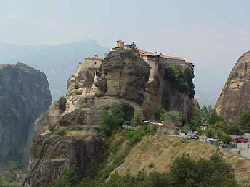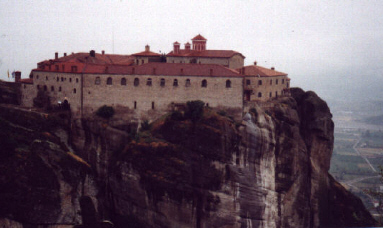| Today six monasteries and convents
are occupied but only two of these are primarily
religious houses, Ayos Stefanos and Aya Triada
(Holy Trinity), the others are essentially tourist sites.
We should have time to visit three of these - probably
the Grand Metoron, Varlaam and Ay Stefnos.
The first monastery on the
hill up from Kastrki is Ayos Nikalaos, a small
monastery established in the 14th century. with superb
paintings by Theophanos in the 16th century
church. Because of the rock shape this monastery faces
due north rather than the usual east.
Further
up and round many bends is the tiny convent of Roussanou,or
Aya Barbara built in the 14th century with its walls
taken to the edge of the rock on all sides! Originally it
would have been occupied by monks as no women were
allowed in the Metora. The chapel has some gruesome 16th
century paintings. We get a lovely view of the convent on
our way back down.
Up
more winding road, the view ever more breathtaking, we
come to a junction. The left turn takes us to the two
biggest (and busiest) monasteries. The first of these, on
a 373 metre peak, is Varlaam which is
reached today by a footbridge and 150 steps, there
are remains of the vrizoni or winch
tower which until the 1920's was the only access.
The
monastery was built on the site of the hermitage of Ay.
Varlam in 1517 by two wealthy brothers from
Ionnina who came here soon after Athansios. Legend has it
that it took 22 years to gather the material for the katholikn
and only 20 days to build it in 1542!
In
the katholikn are painted beams and superb frescoes
from 1548, by Frango Kastellano, including in the narthex
the Last Judgement, the Life of John the
Baptist and in the domes the Ascension and a Pantokrator
In
the refectory are fabulous gold embroidered vestmentsand
a Gospel dating from 960, and in the storeroom is
a wine press and an enormous barrel, two metres diameter,
which can hold 12,000 litres.
Going
on from Varlam we come to the Grand Meteoron (the
Transfiguration)), the highest of all at 615 metres above
sea level; we climb 115 steps down and 220 up to
enter the monastery, passing on the way the cave
where Athansios lived. Access to the monastery was by rope
and net and we can see it still hanging from the vrizonitower;
today it is used only for supplies, not people, and
the mechanism is electric. There is also a bucket on a
cable slung across the chasm also used for supplies.
There is a stunning view of Varlam from here.
The
katholikon is particularly fine, some say the
finest in the Meteora; based on the churches of Mount
Athos it is a cross-in-square, with a lofty dome
supported by columns and beams, originally built in 1383
and enlarged in the fifteenth and sixteenth centuries. Athansios
and Joasph are buried in the narthex. The
iconostasis has some superb icons. The
16th century frescoes, probably by Theophanos, depict
grisly martyrdoms. Also decidedly grisly is the display
of skulls in the ossuary! We can also visit the
vaulted refectory where there are more icons and the domed
kitchens which are arranged as if they had just
been left; there are two huge barrels here.
If
we now turn back and go straight on at the junction we
will come to two more monasteries. First is Ayias
Triados (Holy Trinity) where according to legend it
took 70 years to get all the materials to the site. Here
again there is a winching system, access today is
via 130 steps and a tunnel. The monastery, which was
built in 1438, was restored in the 1980's. There are
magnificent frescoes in the katholikon and some
splendid icons. Four monks still live here.
The
last monastery is Ay. Stefanos which we reach now
by a narrow stone bridge which crosses the ravine. There
are no steps! The nuns who live here will offer you
skirts and wraps to cover bare legs or trousers, and try
to sell you souvenirs. The monastery was built in the
late 15th century on the site of a 12th century
hermitage. The refectory, which has brick domes,
is now a museum with lovely embroidered vestments (C18/19th),
altar silver, an ebony and ivory bishop's throne,
C17/18th icons and a 6th century manuscript, and
others from the 10th - 17th centuries; there is also a dictionary
from 1499. The frescoes in the 18th century church
are newly restored; those in the 15th century chapel are
badly damaged. Last year these were being restored. There
is a pretty rose garden with box hedges and a superb view
over the plain and Kalambaka. Down the steps in the
garden are loos a la Turque!
|


